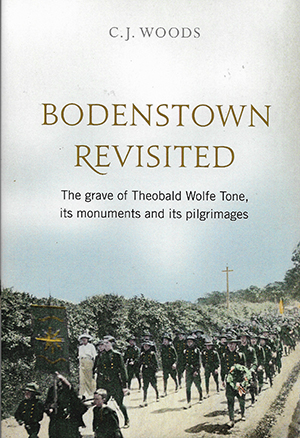BODENSTOWN REVISITED: the grave of Theobald Wolfe Tone, its monuments and its pilgrimages
Published in Book Reviews, Issue 2 (March/April 2019), Reviews, Volume 27C.J. WOODS
Four Courts Press
€45
ISBN 9781846827389
Reviewed by Aengus Ó Snodaigh
Aengus Ó Snodaigh is an author, historian and Sinn Féin TD for Dublin South-Central.
 C.J. Woods’s imposition of the ‘thirty-year rule … to distinguish between history and mere contemporary studies’ leaves many of my connections with Wolfe Tone’s grave and commemoration outside the scope of this fascinating and in-depth account of Tone’s final resting place and its place in Ireland’s history.
C.J. Woods’s imposition of the ‘thirty-year rule … to distinguish between history and mere contemporary studies’ leaves many of my connections with Wolfe Tone’s grave and commemoration outside the scope of this fascinating and in-depth account of Tone’s final resting place and its place in Ireland’s history.
While the book details Tone’s burial place in Bodenstown from 1798 until 1983, it was in the following year, 1984, that I first visited the ‘holiest place in Ireland’ as a young adult and a member of the UCD Sinn Féin Cumann. I’ve seen the Sinn Féin commemorations with large and small crowds. I’ve listened to marching bands and orations by senior party figures, and witnessed the presence of, and the harassment by, members of the Garda Special Branch. I’m ‘old’ enough to remember ‘pilgrims’ on sponsored cycles from Dublin or Belfast, Fianna members hiking there and camping overnight and local cumainn hiring a bus, when not everyone had a car.
Back then Sallins was a small village; it is now a commuter town and some of the magic is fading. The photographs in the book capture some of that magic, but gone are the ‘field’, the Cumann Cabhrach marquees, the traders’ stalls and the extended closing times of the public houses. Nevertheless, it’s still a day to stroll down County Kildare’s country bohereens with friends on ‘Bodenstown Sunday’. Some families still sit on the banks of the Grand Canal and eat the packed picnic.
Over the years ‘Bodenstown Sunday’ (the nearest to Tone’s birthday, 20 June) has often been a packed affair, with sometimes three or four groups vying for space—Republicans (Officials or Provisionals), Fianna Fáil, the IRSP and the Irish Defence Forces. C.J. points out that both ‘Óglaigh na hÉireann’, the IRA and the Defence Forces, would be in attendance at the graveside on the same day. The state’s Defence Forces ceased their commemoration after 1973. Fianna Fáil intermittently commemorated Tone in June after that, until they moved their wreath-laying event to the autumn time.
Who said what, what the themes were, how many were there, the effects of splits etc. are all elaborated upon by C.J. and in a short review I cannot do justice to his tremendous research, including producing a speakers’ list for each nearly annual commemoration since 1873. He highlights the difficulties of trying to accurately record some of the associated history of these commemorations, given that accounts in local, national or even ‘partisan papers like An Phoblacht’ are ‘entirely deficient in telling what was happening behind the scenes’. This is a reality facing historians as they grapple with our turbulent and often clandestine history, with no written or oral records from many of the participants in that history.
The clashes at Bodenstown in 1934, when banners from the Shankill Workers’ Republican Clubs and the Republican Congress started in the 30,000-strong procession and were removed, are described by C.J. He also describes the following year’s clashes, this time without the Shankill contingent, as they had had enough after their first Bodenstown.
As regards talking about the evocation of historical memory, there was no better man to do that than Patrick Pearse—well, at least it seems that Thomas Clarke and the IRB Supreme Council thought so in 1913. So, on 22 June, having been introduced by Thomas Clarke, Patrick Pearse delivered probably his second most famous rousing graveside oration (the most famous was two years later). In Bodenstown Pearse uttered these famous words about Tone:
‘The greatest of all who have died for Ireland whether in old time or in new. He was the greatest of Irish nationalists; I believe he was the greatest of Irish men. And if I am right in this, I am right in saying that we stand in the holiest place in Ireland, for it must be that the holiest sod of a nation’s soil is the sod where the greatest of her dead lies buried?’
Never a man to miss a publicity coup, Tom Clarke had the forethought to have ‘newsreel cameraman and film exhibitor’ James T. Jameson record proceedings. The newfangled medium was, according to Clarke, a means of ‘getting the memorial project well to the front at last’ and ‘before the minds of the younger element’. Pilgrimage to Wolfe Tone’s grave at Bodenstown was played to full picture-halls across Ireland, starting in the Rotunda’s Round Room. Regretfully the film has been lost, as far as I’m aware.
At a recent commemoration I was joined from Australia by one of the ‘advanced students’ who C.J. describes as having been, under the direction of the head of the Bolton Street college’s building department, central to erecting the steel ‘intricate ornamental surround’ around the grave in 1951. I got a lot of history that day.
I thoroughly enjoyed this revisitation by C.J. of his 1989 paper in reaction to Professor Tom Dunne’s assertion that Tone had not been a central figure for nineteenth-century nationalists. C.J. has now added further to our knowledge of Tone, his times, his writing and how he was and is remembered.
For anyone interested in the secrecy of Wolfe Tone’s burial place and how it was ‘located’ and brought out of obscurity to become the focus of an annual commemoration after the Young Ireland leader and writer Thomas Davis ‘rediscovered’ him and wrote his famous ballad, Tone’s Grave, this is a must-read book.
















